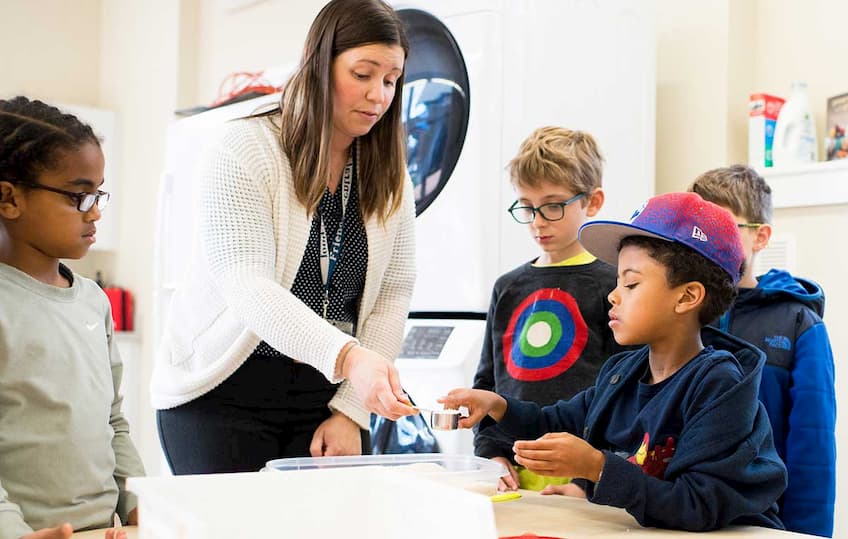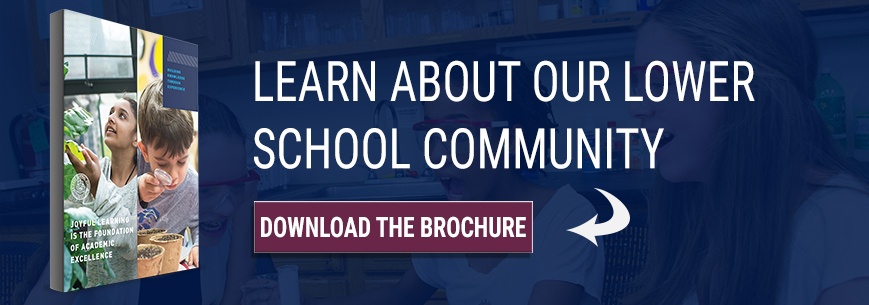
When it comes to evaluating elementary schools for your child, there are many factors that parents should take into consideration. The school’s educational philosophy is a major concern, as is ensuring that the school offers a challenging, but age-appropriate curriculum.
Another factor that parents should keep in mind when identifying schools to apply to is class size. Simply put, while a small class size alone does not ensure a high-quality education, it does come with many powerful benefits which can aid in your child’s development.Free Downloadable Brochure: Take a Closer Look at Friends' Central Lower School
Below, we outline the most important benefits of small classes at the elementary school level.
What is considered a “good” class size?
According to the Center for Public Education, the class size that allows teachers to teach as effectively as possible is 18 students or fewer.
A similar study performed by the National Education Association (NEA) concluded that in kindergarten classes of 13-17 students, children performed at a level that was roughly a month ahead of students in classes consisting of 22-25 students by the end of the year. A followup study concluded that by the end of the second grade, students from the larger classes were approximately two months behind the students from smaller classes.
Despite the evidence, the average class size in the U.S. is currently around 21.2 students, according to the National Center for Education Statistics (NCES). In Philadelphia, even the most well-funded of school districts can include class sizes of 20 to 25 students per classroom and reach a high of 33 students in a single classroom.
On a more local level, the Lower Merion School District has been called the fastest-growing school district in Pennsylvania, with enrollment increasing by 24.6 percent in the past ten years. This has prompted the district to pursue building a new middle school, which is not anticipated to be complete until the Fall of 2022.
Clearly, parents looking for a quality education for their child would do well to seek options at schools with lower average class sizes.
Benefits of Small Elementary Classes
1. Individualized Instruction & Closer Relationships
When class sizes are kept at a manageable level, students benefit from more individualized attention and instruction from their teachers, for obvious reasons. In short, when there are fewer students in a class, a teacher is able to divide their attention more equitably amongst their students.
Ultimately, this allows teachers to gain deeper insights into how well individual students are learning the material. It also enables teachers to reevaluate their own teaching methods to better address areas where students may be struggling, and to better challenge students who need more enrichment.
That individualized attention and instruction offers students a number of benefits. Primarily, it allows teachers to better understand the needs and unique learning styles of each student, and to tailor their approach to best suit those needs. The NEA points out that this aspect of smaller class sizes also allows for the early identification of learning disabilities in students, which enables early intervention and support and fewer special education placements later.
Smaller class sizes also allow for a closer partnership between the teacher and parents. Parents who notice that their child is struggling with a concept are empowered to speak with their child’s teacher, knowing that the teacher has the bandwidth to listen to and address their concerns; similarly, teachers are empowered to communicate their own observations to parents.
2. Social Development
In larger classrooms, it can be difficult for children to develop strong relationships with all of their classmates. After all, in a typical school day there is only so much time that can be dedicated to group learning or collaborative activities, and cycling through 25-30 students is quite a challenge. Smaller classrooms allow for closer relationships between students, which in turn promotes healthy social development.
When students feel truly known by their classmates and teachers, they are better enabled to push the boundaries and challenge themselves—knowing that they will be encouraged and supported, even if they fail. Embracing this mindset early in life sets a child up to embrace curiosity and exploration, both of which are critical to a successful academic career.
3. Participation & Hands-on Learning Opportunities
Hands-on learning comes with many benefits for young learners. Hands-on learning and participation gives students an opportunity to practice their education and understand how their learning translates into real-world problem solving. It also often results in something real—a physical project item which can act as a representation of education-in-action. And for many students it is simply a more engaging way to learn, which can lead to increased retention.
Similarly, classroom participation (in the form of question-and-answer sessions, active reading, and and discussion) has been shown to lead to improved test scores by enabling students to engage with the course material and making learning a more active, instead of passive, activity.
Because smaller classrooms are easier for a teacher to manage, small classroom sizes can facilitate more participation and hands-on learning opportunities. Simply put, it is easier for a teacher to organize a classroom of fifteen students into groups or partnerships than it would be for the same teacher to do with twenty students, or twenty-five.
Choosing the Right School for Your Child
As shown above, the benefits of small class sizes for students are substantial—individualized attention from and closer relationships with teachers, improved social development, and increased opportunities for participation and hands-on learning—all of which can lead to improved academic performance and happier students.
When evaluating elementary schools for your child, it is important to note the school’s student-to-teacher ratio and average class size so that you can better understand the level of support that your child can expect as a student at the school.



